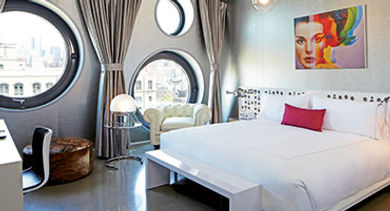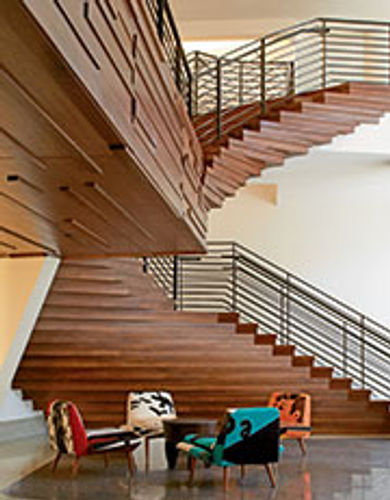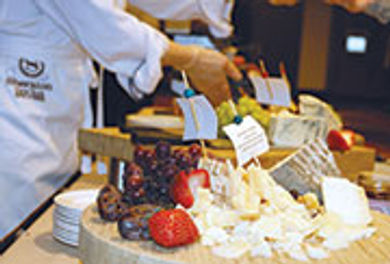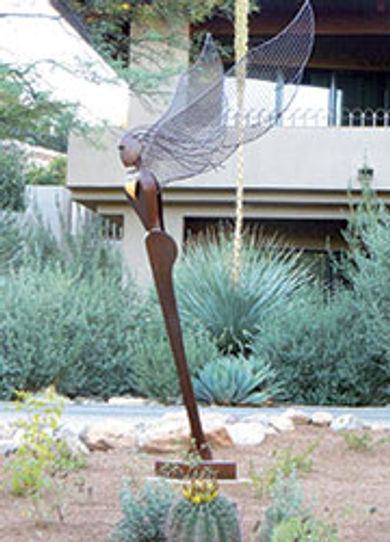
The downtown hotel scene in major cities throughout the U.S. is hot -- and getting hotter. Areas once seen as too gritty or hectic are now in demand for groups seeking a memorable, distinctive experience. Proximity to a city's culture, music, art, and trendy eateries and lounges has become a major selling point for meeting planners. And the rise of hip hotel chains and efforts from established brands to connect with the local nightlife are drawing more groups to the heart of the city.
"We all know one size doesn't fit all and a downtown location satisfies a variety of personalities and age groups. The attendee is literally steps away from all the local flavor of the destination. If the attendee wants to go to a restaurant, a jazz club, or take a river cruise -- downtown is an affordable playground for adults," explains Debra Dohnert, CMP, senior manager of meetings, special events and travel for the American Institute of Certified Public Accountants (AICPA). "It is also a cost savings to the organization since it doesn't have to arrange buses to different locations with time constraints."
?
The most successful downtown hotels provide a sense of place. "Guests want to have an authentic experience; they want to have really been to a place, as opposed to being dropped into a homogenous environment that could be located anywhere," says Elizabeth Lowrey, principal and director of interior architecture for Elkus Manfredi Architects. "They want to walk away having experienced the vibe, the personality of a city or neighborhood." She adds that hotels should "be a window into that particular culture," showcasing the specific spirit or point-of-view of the city in which they are based.
An important attraction for today's attendees is the prominence of a music and entertainment scene -- and hotels are taking note. Aloft Hotels has made live music central to its brand identity, so much so that last year it launched 100 Days of Music, which saw the Starwood sub-brand host a marathon of live concerts in the Aloft event spaces, open to guests and the public alike. Launched in 2008, the Aloft brand has worked to fill a niche for travelers seeking a destination offering top-quality amenities and chic design, but with a casual, welcoming feel that appeals to younger generations of both business and leisure travelers.
"You can just come down to the bar and be part of something. It's not pretentious and is totally approachable," says Paige Francis, vice president of global brand management for Aloft Hotels. "When you travel, you are looking for a great vibe, and a good energy." Francis points out that while the 100 Days of Music is putting a spotlight on this particular series of concerts, every Aloft property makes music a key part of its identity and hosts musical events year-round. For example, one of its newest properties, Aloft Liverpool, is in the heart of the city center that's home to The Beatles. The brand has built a following with its Live at Aloft Hotels music programming as a way to experience local emerging artists up close and personal.? ?
?
 Design elements like the floating
staircase in The James Royal Palm
give downtown hotels a chic feel
Design elements like the floating
staircase in The James Royal Palm
give downtown hotels a chic feelThe James hotels located in New York, Chicago, and Miami bring local cultural experiences into their properties in interactive ways. The inaugural collection draws from relevant cultural touch points, including art, literature, film, cuisine, music, and comedy. For example, the Second City comedy improv group started in Chicago and is now featured at The James Chicago. The Second City is part of its Curated Meeting Break program where groups have an interactive session with a Chicago comedy twist.
"The James' Cultural Collection brings the most captivating elements of each of the local communities into our hotels and provides special offers and access unique to our guests. It's about offering anticipatory services in the hotel, as well as our role supporting the arts within each city," says Lisa Zandee, senior vice president of brand management for The James.
Story Club is a nonfiction storytelling show that combines the spontaneity of an open-mic night with the experience of live theater. Each show features members of the "live lit" community in Chicago telling a story in eight minutes or less. JIMMY at The James Chicago hosts a monthly Story Club event open to hotel guests and locals, where performers can tell a nonfiction story live. A special Story Club cocktail is created by JIMMY partner, Johnny Swet, for each show.
These programs aren't limited to Chicago. The James New York partners with the Lower East Side Film Festival to screen outdoor films in its Urban Garden, and offers a selection of in-room independent movies for guests to watch.
Bringing Downtown Inside?
There are some hotels that have mastered the art of bringing the energy of downtown into the property itself. Take Dream Downtown, set between the Meatpacking District and Chelsea in New York City. By day, guests gather in The Lobby Lounge for coffee, a small bite, or business meeting. The mid-day ambiance is complete as sunrays filter down through the glass bottom outdoor pool, which is located directly above. As nighttime rolls in, coffee turns to cocktails, the lights are dimmed, and the lounge is injected with a Manhattan energy as one of the hotel's resident DJs sets the mood with pulsating music.
"Dream is a brand that is deeply rooted in art and culture," says Ayo Akinsete, general manager of Dream Downtown. "We take pride in incorporating local influences to provide our guests a uniquely cosmopolitan experience."
Wyndham Grand Jupiter at Harbourside Place in Jupiter, FL, is another property that brings a DJ into its lobby every Saturday night. The hotel also partners with Harbourside Place, a downtown destination for shopping, dining, and entertainment, to offer guests special local experiences.
Not only are DJs popular, but regional genres of music as well. Hilton New Orleans Riverside brings music of the French Quarter into the hotel. A brass band plays traditional New Orleans jazz to welcome groups to the property.
Local art is another way hotels are offering a downtown feel. Conrad Miami displays the work of local artists in the lobby to not only bring in culture but to give guests the opportunity to purchase it as well. The art displays change every three to six months.
?
The Westin La Paloma Resort & Spa in Tucson, AZ transforms a number of its outdoor paths into an art walk with rotating works of for-sale art consisting of metal, steel, stone, and glass from the Metal Arts Village, Arizona's premier collection of metal artisans.
Music, art, and iconic food-and-beverage offerings are just a few of the cultural offerings featured in downtown hotels. As an increasing number of groups demand authentic experiences, those properties that possess the personality of the city or neighborhood are prospering.
Questions or comments? Email adoyle@ntmllc.com
This article appears in the March 2015 issue of Successful Meetings.
Locally Sourced F&B?
Another way hotels are adding local flair to meetings and events is with food and beverage. The 391-room Trump SoHo New York showcases local vendors in its meeting menus with purveyors like Magnolia Bakery and Laughing Man Coffee on offer.
The physical meeting space itself brings the downtown in, says Mary Mayes, Trump SoHo's director of sales and marketing. For example, the 1,600 square-foot SoHi (located on the 46th floor), offers one of the ultimate event spaces in Manhattan with 15-foot floor-to-ceiling windows and sweeping skyline views of the Hudson River, Statue of Liberty, and Freedom Tower. ?
The Ritz-Carlton, Philadelphia, includes food and beverage sourced from the City of Brotherly Love, including a Tastykake break, Taste of Philly break, and a South Philly buffet. The culinary team at the Hilton Chicago recently hosted a food truck lunch to showcase Chicago as a city of neighborhoods. The trucks featured items from each region of Chicago -- tacos from Pilsen, Chicago-style hot dogs from Wrigleyville, and Korean-style sandwiches from Koreatown.
?
The Sheraton New York Times Square often partners with local New York City food icons such as Murray's Cheese, Zabar's, and Artisanal, as well as preserves from Beth's Farm Kitchen, to provide locally sourced foods that meeting attendees may not get to taste otherwise during packed meeting schedules.
The American Sociological Association (ASA) incorporated New York-centric foods into its 2013 meeting for 6,000 attendees, held at both the Sheraton and Hilton New York Midtown. "We try to link our program to the city and region we are holding that meeting in. Those linkages take the form of individual sessions, restaurant guides, and a series of articles written by member sociologists," says Kareem D. Jenkins, director of meeting services for ASA. During this meeting, the ASA celebrated "New York City in the 80s" with a flash mob that danced to songs from Madonna and Run-D.M.C.
"We try to offer the life and blood of the culture, recognizing our attendees might not have time to venture into every nook of the city," adds Jenkins. They also hosted a regional marketplace where local small businesses sold their wares.
Hyatt Hotels Corporation is bringing downtown into its properties with its recently launched Hyatt Centric brand. More than 15 Hyatt Centric properties are slated to debut this summer in the heart of some of the world's most popular cities, including New York, Paris, Atlanta, Chicago, and Miami.
Marriott is also getting in on the cosmopolitan movement with AC Hotels by Marriott. The signature element of these hotels is its innovative beverage and food program within its AC Lounge. A twist on the traditional hotel bar, the experience includes craft beers, on-tap wines, handcrafted cocktails, and a selection of small tapas-style plates served by city-savvy bartenders. These beverage experts connect AC patrons to the pulse of the city with their insider tips and recommendations on the local area, acting as both mixologist and concierge.
Voodoo Magic
Voodoo, like jazz music, Mardi Gras, and even New Orlean's traditional Spanish architecture, is an integral part of New Orleans.
It is interwoven into its culture among the aged streets and centuries-old oak trees that make the city the distinctive place it is.
Debra Dohnert, CMP, senior manager of meetings, special events and travel for the American Institute of Certified Public Accountants (AICPA), took this local culture and incorporated it into a meeting she planned at The Ritz-Carlton, New Orleans, located at the edge of the French Quarter. The hotel itself features a sense of place set in the 1908 beaux-arts Maison Blanche building. She themed an event for an AICPA meeting at the property last summer, "Voodoo on the Bayou."
"I found a woman in the Quarter who makes perfumes and hired her to make custom-blended scents or 'potions' for my attendees. I also brought in an apothecary room that featured herbs to make Gris-Gris bags. Not only was this a fascinating touch but added an interactive element as well," says Dohnert.? A highlight of the reception was a custom champagne cocktail Dohnert helped create that was dedicated to Voodoo Queen Marie Laveau. "I infuse a sense of place into all the meetings I plan," says Dohnert.
Locally Sourced F&B?
Another way hotels are adding local flair to meetings and events is with food and beverage. The 391-room Trump SoHo New York showcases local vendors in its meeting menus with purveyors like Magnolia Bakery and Laughing Man Coffee on offer.
The physical meeting space itself brings the downtown in, says Mary Mayes, Trump SoHo's director of sales and marketing. For example, the 1,600 square-foot SoHi (located on the 46th floor), offers one of the ultimate event spaces in Manhattan with 15-foot floor-to-ceiling windows and sweeping skyline views of the Hudson River, Statue of Liberty, and Freedom Tower. ?
The Ritz-Carlton, Philadelphia, includes food and beverage sourced from the City of Brotherly Love, including a Tastykake break, Taste of Philly break, and a South Philly buffet. The culinary team at the Hilton Chicago recently hosted a food truck lunch to showcase Chicago as a city of neighborhoods. The trucks featured items from each region of Chicago -- tacos from Pilsen, Chicago-style hot dogs from Wrigleyville, and Korean-style sandwiches from Koreatown.
?
 The Sheraton New York Times Square
partners with local NYC food icons
such as Murray's Cheese to provide
locally sourced foods
The Sheraton New York Times Square
partners with local NYC food icons
such as Murray's Cheese to provide
locally sourced foodsThe Sheraton New York Times Square often partners with local New York City food icons such as Murray's Cheese, Zabar's, and Artisanal, as well as preserves from Beth's Farm Kitchen, to provide locally sourced foods that meeting attendees may not get to taste otherwise during packed meeting schedules.
The American Sociological Association (ASA) incorporated New York-centric foods into its 2013 meeting for 6,000 attendees, held at both the Sheraton and Hilton New York Midtown. "We try to link our program to the city and region we are holding that meeting in. Those linkages take the form of individual sessions, restaurant guides, and a series of articles written by member sociologists," says Kareem D. Jenkins, director of meeting services for ASA. During this meeting, the ASA celebrated "New York City in the 80s" with a flash mob that danced to songs from Madonna and Run-D.M.C.
"We try to offer the life and blood of the culture, recognizing our attendees might not have time to venture into every nook of the city," adds Jenkins. They also hosted a regional marketplace where local small businesses sold their wares.
Hyatt Hotels Corporation is bringing downtown into its properties with its recently launched Hyatt Centric brand. More than 15 Hyatt Centric properties are slated to debut this summer in the heart of some of the world's most popular cities, including New York, Paris, Atlanta, Chicago, and Miami.
Marriott is also getting in on the cosmopolitan movement with AC Hotels by Marriott. The signature element of these hotels is its innovative beverage and food program within its AC Lounge. A twist on the traditional hotel bar, the experience includes craft beers, on-tap wines, handcrafted cocktails, and a selection of small tapas-style plates served by city-savvy bartenders. These beverage experts connect AC patrons to the pulse of the city with their insider tips and recommendations on the local area, acting as both mixologist and concierge.
Millennial Magnet
The rise of downtown is partly due to the fact that such attractions especially appeal to younger attendees who want to be in the center of the action. "The more unique the hotel is, the more interesting it will be to Millennials. Not only are they focused on the hotel itself, but the experience they will have in and around the property," says Jeff Fromm, a marketing strategy consultant and president of FutureCast, a Kansas City, MO-based Millennial marketing consultancy who frequently speaks about consumer trends to professional organizations. Fromm is the co-author of Marketing to Millennials and his new book Millennials with Kids: Marketing to Millennials as New Parents,?will be out this summer.
The younger generation enjoys local and authentic experiences, says Fromm. "Hotels need to think more broadly about the restaurants and entertainment alternatives outside their four walls to ensure Millennials can explore."
Bringing Downtown Inside?
There are some hotels that have mastered the art of bringing the energy of downtown into the property itself. Take Dream Downtown, set between the Meatpacking District and Chelsea in New York City. By day, guests gather in The Lobby Lounge for coffee, a small bite, or business meeting. The mid-day ambiance is complete as sunrays filter down through the glass bottom outdoor pool, which is located directly above. As nighttime rolls in, coffee turns to cocktails, the lights are dimmed, and the lounge is injected with a Manhattan energy as one of the hotel's resident DJs sets the mood with pulsating music.
"Dream is a brand that is deeply rooted in art and culture," says Ayo Akinsete, general manager of Dream Downtown. "We take pride in incorporating local influences to provide our guests a uniquely cosmopolitan experience."
Wyndham Grand Jupiter at Harbourside Place in Jupiter, FL, is another property that brings a DJ into its lobby every Saturday night. The hotel also partners with Harbourside Place, a downtown destination for shopping, dining, and entertainment, to offer guests special local experiences.
Not only are DJs popular, but regional genres of music as well. Hilton New Orleans Riverside brings music of the French Quarter into the hotel. A brass band plays traditional New Orleans jazz to welcome groups to the property.
Local art is another way hotels are offering a downtown feel. Conrad Miami displays the work of local artists in the lobby to not only bring in culture but to give guests the opportunity to purchase it as well. The art displays change every three to six months.
?
 The Westin La Paloma Resort
& Spa in Tucson, AZ transforms
a number of its outdoor paths into
an art walk with rotating works
The Westin La Paloma Resort
& Spa in Tucson, AZ transforms
a number of its outdoor paths into
an art walk with rotating worksThe Westin La Paloma Resort & Spa in Tucson, AZ transforms a number of its outdoor paths into an art walk with rotating works of for-sale art consisting of metal, steel, stone, and glass from the Metal Arts Village, Arizona's premier collection of metal artisans.
Music, art, and iconic food-and-beverage offerings are just a few of the cultural offerings featured in downtown hotels. As an increasing number of groups demand authentic experiences, those properties that possess the personality of the city or neighborhood are prospering.
Questions or comments? Email adoyle@ntmllc.com
This article appears in the March 2015 issue of Successful Meetings.